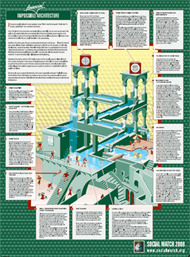Impossible Financial Architecture
|
Published on Mon, 2010-07-12 09:37
Finances are usually explained in water metaphors: money "flows", benefits from growth "trickle down" to the poor, capital "leaks" out of countries to tax havens… From a first glance at this construction, most people will see a waterfall, in the very same way that most of the public in rich countries thinks there is an enormous flow of their tax contributions to poor countries, in the form of aid, loans, trade benefits and frequently talked about debt cancellations. If poverty still persists it must somehow be the fault of the poor people themselves or their governments. Now look at the picture again. The water cascading down doesn't quite reach the poor… Instead it is diverted and –against all rules of logic– while always running down it still ends up at the top again in a futile cycle. The illustration, inspired by the famous "Waterfall" etching by MC Escher, is a good metaphor for the current "global financial architecture", an architecture that prominently features the Bretton Woods institutions (the World Bank and the International Monetary Fund - IMF), even when they fail at the objectives they were created for: to ensure financial stability, full employment and development. Remittances from migrant workers to their families in poor countries actually surpass in volume all the aid their countries receive. And it is the revenue from local taxpayers (or what is left of it once the external debts are paid for) that provides for most of the basic social services like education and health. If only the leaks could be plugged, there would be enough resources to provide the conditions of a dignified life for all of the people on the planet. But that would require a substantial redefinition of the present "impossible architecture" of global finances. The Social Watch Report 2006 explains the problem as seen by citizens from around the world and provides new perspectives and ideas for a viable blueprint that makes finances actually work for poverty eradication and development.
» |
SUSCRIBE TO OUR NEWSLETTER



